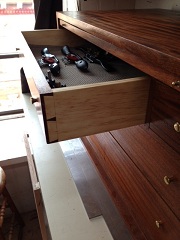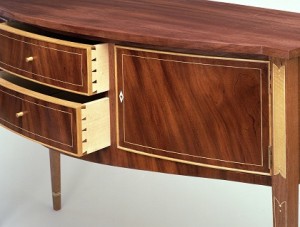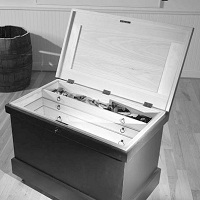We may receive a commission when you use our affiliate links. However, this does not impact our recommendations.
I met Evan Court last month at CraftBoston, where he was representing the North Bennet Street School as one of the students in their furniture-making program. Here’s a brief and informal introduction for you – Evan’s latest work, a great sideboard that was on display at the show:
But what I really want to tell you about is Evan’s first project for the furniture-making program: his tool chest.
 Tool chest? You might ask: Why are we talking about tool chests when there’s that sideboard sitting right there? Well, in Evan’s words, “When I built my sideboard I had an epiphany that it was essentially just a giant toolbox with a curved front and legs. Our tool chest project is the root of [the rest of our] casework.”
Tool chest? You might ask: Why are we talking about tool chests when there’s that sideboard sitting right there? Well, in Evan’s words, “When I built my sideboard I had an epiphany that it was essentially just a giant toolbox with a curved front and legs. Our tool chest project is the root of [the rest of our] casework.”
Or, in my own words, if you can build a box then you can build a cabinet. If you can build a fancy box, then you can build a great sideboard. And it’s all the better if the box you build also serves the valuable purpose of organizing your tools.
Here are three specific skills that Evan learned in building his tool chest that transferred to the sideboard:
- Dovetailing. Lots and lots of dovetailing.
- Efficiency. “Keep the project moving.” While the case glue is drying, start milling the interior parts, for example.
- Drawer fitting. This traditional skill comes in handy in all sorts of casework. It’s also a big challenge for many woodworkers. Better to start now, and best to start on a functional piece that won’t “show” as much.
The beauty of any tool chest project is, in my own view:
- Since you know you won’t be displaying, selling or giving away the finished piece, it takes the pressure off. Sometimes you end up doing your best handwork when it’s “just for the shop.” It’s a confidence-builder.
- Like all shop projects, you get to enjoy the results for many months, and possibly years. And you enjoy it because you’re using it to build more projects, which is different from a piece of furniture.
We have a wealth of tool storage projects in the Popular Woodworking list. I’ll be going into more detail on them, and offering some freebie plans, as we move forward. Today I wanted to mention a brand new DVD release from Christopher Schwarz, “A Traditional Tool Chest in Two Days.” I watched the video and I definitely endorse the product, especially if you’re more on the functional side of woodworking than the decorative side. Buy it and build it, and you’ll learn some really solid skills.
We’ve had a nice conversation going on Facebook and Twitter this week, featuring some readers’ tool storage projects. Let’s keep that conversation going here on the blog. Please comment on any of the above (my words or Evan’s), and I’ll moderate!
Here are some supplies and tools we find essential in our everyday work around the shop. We may receive a commission from sales referred by our links; however, we have carefully selected these products for their usefulness and quality.











Dan,
Which version of chest does the DVD focus on? I assume the Anarchist’s Tool Chest given the cover photo of the DVD but wanted to confirm. Also the sample video is dedicated to the Dutch chest so I am wondering if it is covered perhaps to lesser detail than the ATC. Is it a “how to” type video with step by step instructions to build the chest?
I am undecided at this point as to which chest will suit my needs best and am waiting for the PW issue (I think in Sept) which will feature the Dutch chest.
Thanks, Dave
I second the use of larger photos. What happened? The smaller photos are OK for the article, but clicking on them should bring up a large image.
Al Navas
Country Club, Missouri, USA
I wish you would have shown more photo’s of the sideboard and his tool box. Also make the photo’s bigger than the small icon’s you are using. I am old and half blind, and just need to have a bigger image to view them. That is why I like the computer, I can enlarge the type, photo’s etc. so I can see them. Thanks for the information however.
I would kindly suggest that Kevin Court has way too much time on his hands to build such a nice tool chest!
I’ve read Chisel, Mallet, Plane and Saw by Tony Konovalov (sp?) and Chris Schwarz’s The Anarchist’s Tool Chest. They both use similar chests with incredibly dissimilar interior partitioning.
I’m currently using a wall mounted rack and a table to house my tools. I’m torn between the Konovalov and Schwarz camps for a compact chest solution. I’ll probably build the chest and fret over the interior until I settle on something that in the end simply suits me. 🙂